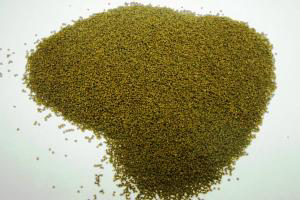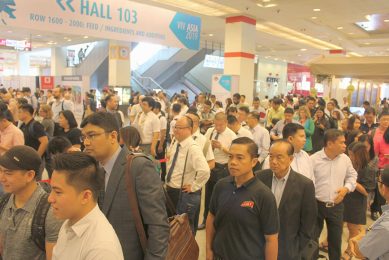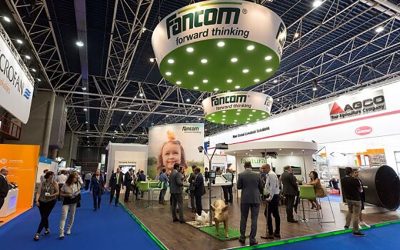How extrusion can become profitable for shrimp feeds

Victam Asia 2012, held in February, was the location for the first ever Aquafeed Innovation Awards for excellence. In the aquatic feed category for processing technology Wenger won with its C²TX extrusion cooker, which was specifically designed to produce small diameter shrimp feeds.
By Joe Kearns, aquaculture process engineering manager, Wenger Manufacturing, Sabetha Kansas, USA
Wenger, already working in extrusion technology since 1935, developed a design to maximise production of small diameter aquatic feed with special emphasis on shrimp feed. This design was based on Wenger’s versatile C2TX , conical co-rotating twin screw extruder, but tailored specifically for small diameter aquatic feeds. The design changes included the revolutionary new high shear conditioner (HSC) and oblique tube die (OTD). All three technologies, the C²TX, HSC conditioner and the OTD are all individually patented ideas by Wenger. The C²TX is a conical co-rotating twin screw extruder and as originally designed it was already an extremely responsive machine that quickly adapts to process variables such as recipe moisture, recipe temperature, cook in the preconditioner, and extruder speed. It was only natural that the C²TX Model 8.1 has become the foundation for a Wenger extrusion process specifically intended for shrimp, and other small and micro-diameter aquatic feeds. The simplicity and flexibility provided by the C²TX design coupled with the patented new technology yielded unmatched performance in producing these distinct feeds.Historically, extrusion systems were limited mainly in capacity on small diameter feeds. Extruders could always make small sinking feeds but with some compromises. Lack of capacity, making a dense enough feed and running continuously were forefront in why this machine was developed. Prior to its development, capacities were low and in the 1-2 tonnes per hour range (Table 1). Feed densities were in the 600 to 620 g/litre area and screw designs for both single and traditional twin screw extruders allowed for build up in the barrel over time and thus eventually die blockage, causing shut downs for cleaning. Hence, most manufacturers retained the pelleting processes for this range of product. The advanced C²TX Small Diameter Aquatic Feed Extrusion System addressed all of these concerns and more bringing the advantages of extrusion back into popularity for these feeds and specifically shrimp feeds.
Increased capacity
Wenger’s oblique tube die technology coupled with this advanced twin screw technology process for shrimp and small-diameter aquatic feed provides a number of advantages over traditional processes. Capacities are up by 3 to 5 times or some cases 5-6 tonnes per hour. This is diameter and formulation dependent but the ability to produce products down to 0.8 mm in size that are similar in density to pelleted feeds is being done. It is not unusual to see feed densities of 680 to 715 g/litre out of this process. Capacities range from 2 t/hr for 0.8mm sinking feeds and up to 4-6 t/hr for 1.5 to 2.2 mm feeds.Continuous operation requires a clean system for these micro feeds and fine grinding and sifting directly prior to the extrusion process. In many cases this was not enough, the smooth bore and continuous flight screws in a C²TX extrusion system eliminated all possible dead spots caused by ribbed heads, shearlocks and screws designed to disrupt the flow in the extruder barrel addressing these areas.
Other benefits of extrusion cooking in general include; higher starch gelatinisation, higher production rates, improved size uniformity, less fines in the feed and increased water stability.
High shear conditioning
How is maximum product density achieved with this system? It starts with the new high shear conditioning. This extrusion system is complete with the Model 570 High-Shear Conditioner, which allows an increase in the ratio of steam and water into the aquatic mix. This results in much quicker penetration of heat and moisture into the feed particles, compared to conventional conditioners.Steam and water are injected into the large-diameter end of the conditioner. As the diameter and volume decrease toward the smaller end of the unit, shear rate is increased. At the same time, the product is exposed to an elevated mixing intensity, resulting in 85 to 90% gelatinisation of the starch in micro-ground shrimp food formulas at 4,000 to 5,000 kg/hr. An additional advancement is the fact that when you go from an area of larger volume to an area of smaller volume in situations like this you degas or remove the air from the mix. This cylinder has a vent in the middle of the unit allowing air to be removed prior to the extruder barrel. Finally the conical co-rotating screw design allows for the continued de-aeration of the mix for maximum product density, providing exceptional sinking properties. The special high capacity oblique tube die assembly further adds to the efficiency for sinking feeds. The long tubes increase the cook cycle and decrease expansion through a pressure drop and retention time. Plus, the adjusted die design results in a uniform cross-sectional flow, and eliminate the capacity restrictions previously inherent in the extrusion of small diameter feeds.
Control cooking
An added potential benefit is coupling a back pressure valve (BPV) between the extruder and the oblique tube die. This allows for further control of cook when ever changing formulations are used. As an example high level vegetable protein diets require additional cook and this can be achieved at the operators finger tips. Close the valve while running and the cook goes up, open and the cook goes down regardless of the final die open area, a simple and effective addition to any extrusion operation.
Greater flexibility in the formulation is an additional benefit with this advanced extrusion system. This extruder offers much greater flexibility in the recipe than pelleted feed. Protein levels in diets, for instance, can be varied from 25-45%, high vegetable or high aquatic meal based depending on the species and the culture system used, extensive, semi-intensive, intensive, or super intensive. Fat levels can also exceed those of pelleted products plus, the extrusion process allows the use of less expensive starch sources not to mention lower levels required for product durability.
Potential profit
There is a potential profit margin for switching from pelleting to extrusion for shrimp and small diameter aquatic feed production. It starts with higher rates of production – from three to five times greater than previous technology. Much smaller feeds can be produced while offering a greater potential forsavings in recipe costs as well as the elimination of special binders being required. Some extruded recipes, for example, were reported to start at a $20-50/tonne potential savings over pelleted recipes and go up from there.Last, but not least, is the effect of extrusion on feed performance. In one study, shrimp survivability increased from 75% on pelleted feed to 88.9% on extruded feed. At the same time, final weight increased with extruded feeds, while daily intake and the cost of shrimp produced decreased. Additional studies are underway presently and the continued advancements and results will be available in the near future.










